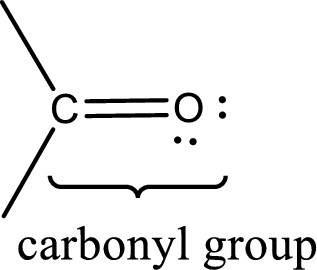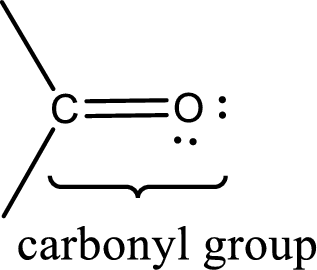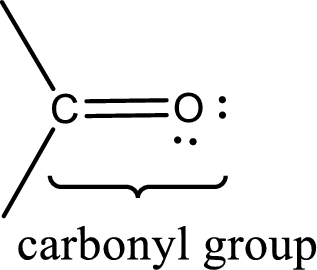
(a)
Interpretation:
Aldehyde must contain a carbon‑oxygen single bond or not has to be indicated.
Concept Introduction:
Carbonyl groups are the one which contain a double bond between carbon and oxygen atom.

The groups that is attached to the carbonyl carbon atom can be either hydrogen or carbon atom. If the attached atoms are hydrogen and a carbon atom means then the compound is an aldehyde and if they are two carbon atoms means then the compound is a ketone. If the attached atom is a nitrogen atom to the carbonyl carbon atom means it is a amide. If a hydroxyl group is attached to a carbonyl carbon atom, then it is a
(b)
Interpretation:
Ketone must contain a carbon‑oxygen single bond or not has to be indicated.
Concept Introduction:
Carbonyl groups are the one which contain a double bond between carbon and oxygen atom. Aldehydes and ketones possess this carbonyl functional group in it. The structural representation of a carbonyl group can be given as shown below,

The groups that is attached to the carbonyl carbon atom can be either hydrogen or carbon atom. If the attached atoms are hydrogen and a carbon atom means then the compound is an aldehyde and if they are two carbon atoms means then the compound is a ketone. If the attached atom is a nitrogen atom to the carbonyl carbon atom means it is a amide. If a hydroxyl group is attached to a carbonyl carbon atom, then it is a carboxylic acid. If one of the bonds in the carbonyl carbon atom is attached to an oxygen atom that is bonded with alkyl, cycloalkyl or aromatic system is known as ester.
(c)
Interpretation:
Ester must contain a carbon‑oxygen single bond or not has to be indicated.
Concept Introduction:
Carbonyl groups are the one which contain a double bond between carbon and oxygen atom. Aldehydes and ketones possess this carbonyl functional group in it. The structural representation of a carbonyl group can be given as shown below,

The groups that is attached to the carbonyl carbon atom can be either hydrogen or carbon atom. If the attached atoms are hydrogen and a carbon atom means then the compound is an aldehyde and if they are two carbon atoms means then the compound is a ketone. If the attached atom is a nitrogen atom to the carbonyl carbon atom means it is a amide. If a hydroxyl group is attached to a carbonyl carbon atom, then it is a carboxylic acid. If one of the bonds in the carbonyl carbon atom is attached to an oxygen atom that is bonded with alkyl, cycloalkyl or aromatic system is known as ester.
(d)
Interpretation:
Carboxylic acid must contain a carbon‑oxygen single bond or not has to be indicated.
Concept Introduction:
Carbonyl groups are the one which contain a double bond between carbon and oxygen atom. Aldehydes and ketones possess this carbonyl functional group in it. The structural representation of a carbonyl group can be given as shown below,

The groups that is attached to the carbonyl carbon atom can be either hydrogen or carbon atom. If the attached atoms are hydrogen and a carbon atom means then the compound is an aldehyde and if they are two carbon atoms means then the compound is a ketone. If the attached atom is a nitrogen atom to the carbonyl carbon atom means it is a amide. If a hydroxyl group is attached to a carbonyl carbon atom, then it is a carboxylic acid. If one of the bonds in the carbonyl carbon atom is attached to an oxygen atom that is bonded with alkyl, cycloalkyl or aromatic system is known as ester.
Want to see the full answer?
Check out a sample textbook solution
Chapter 15 Solutions
EBK GENERAL, ORGANIC, AND BIOLOGICAL CH
- Identify the chiral carbon in each of the following compounds: a. citronellol; one enantiomer has the odor of geranium b. alanine, an amino acidarrow_forwardGalactose can exist as a cyclic hemiacetal because one of the alcohol groups reacts with the aldehyde. 1 2 3 4 он он о Н Он Он о CH2-CH-CH-CH-CH-C-H 6. CH2-OH OH C он 10 он C 8. H. H. OH Which carbon atom of the cyclic hemiacetal was originally a part of the aldehyde group? Carbon: Which alcohol group in the open-chain structure became a part of the cyclic hemiacetal? Alcohol:arrow_forwardWhat is the common feature between an aldo- hexose and a ketohexose: A The number of secondary alcohol functions B The number of carbonyl groups C The number of asymmetric carbons D The number of primary alcohol functions E The nature of their carbonyl grouparrow_forward
- Define the following terms: a. ganglioside b. sphingolipidoses c. isoprenoid d. terpene e. mixed terpenoidarrow_forwardClassify the following lipid (choose all that apply).CHOOSE ALL THAT APPLY a. omega-6 b. trans alkene(s) c. omega-3 d. wax ester e. saturated f. monounsaturated g. fatty acid h. triglyceride i. steroid j. polyunsaturated k. cis alkene(s)arrow_forwardDefine the following terms: a. hydrocarbon b. hydrophilic c. hydrophobic d. functional group e. R grouparrow_forward
- Desferal (Desferrioxamine B) is a drug given to thalassaemic patients who are being treated by blood transfusion and who suffer from iron overload. Desferal contains which of the following iron binding groups: Select one: a. Carboxylic acids. b. Hydroxamates. c. Carboxylates. d. Hydroxamic acids. e. A mixture of carboxylates and hydroxamates. ----- is it hydroxamates or hydroxamic acids?? and what is the difference between them?arrow_forwardIndicate whether each of the following statement about enantiomers is True or False. a. Enantiomers always have the same molecular formula. b. Enantiomers always have the same structural formula. c. Enantiomers are always nonsupetrimposable mirror images of each other. d. Enantiomers always differ in handedness.arrow_forwardCatalytic hydrogenation, used in the food industry, converts double bonds in the fatty acids of the oil triacylglycerols to —CH2— CH2—. How does this affect the physical properties of the oils?arrow_forward
- In observing a Haworth or cyclohexane-chair representation of alpha-d-glucopyranose, the anomeric carbon can de best identified by: a) the carbon atom which is bonded to the most H atoms b) the carbon atom which is bonded to the least H atoms c) The carbon atom which has its OH group pointing down d) The carbon atom which is bonded to two oxygen atoms Cellulose differs from amylose in that: a) cellulose has 1-6 branches while amylose does not b) amylose has 1-6 branches while cellulose does not c) amylose has alpha glycosidic bonds while cellulose has beta glycosidic bonds d) cellulose contains sulfate while amylose does not. The glycosaminoglycan (mucopolysaccharide) which is not normally associated with joint tissue is: a) heparin b) keratan sulfate c) chondroitin sulfate d) hyaluronic acid In glycoproteins, which amino acid does not bond sugar molecules? a) Asn b) Ser c) Thr d) Gly Which feature do all lipid molecules share in common? a) fatty acid molecules…arrow_forwardA monosaccharide designated as an aldehyde sugar contains (a) a terminal carboxyl group (b) an internal carboxyl group (c) a terminal carbonyl group (d) an internal carbonyl group (e) a terminal carboxyl group and an internal carbonyl grouparrow_forwardWhat type of hydrocarbons are their structures? Please describe their stability and chemical reactivity. Fumaric Acid, Capric Acid, Lauric Acid, Myristic Acid, Naphthalene, Diphenyl, Decane, Eicosane, alpha-D-Galactose, alpha-D-Glucose, beta-D-Fructose, and Sucrose.arrow_forward
 Biology (MindTap Course List)BiologyISBN:9781337392938Author:Eldra Solomon, Charles Martin, Diana W. Martin, Linda R. BergPublisher:Cengage Learning
Biology (MindTap Course List)BiologyISBN:9781337392938Author:Eldra Solomon, Charles Martin, Diana W. Martin, Linda R. BergPublisher:Cengage Learning
